A faint smell of horses fills our noses as we walk past the outer wall of the Royal Andalusian Riding School in Jerez. As soon as we step through the entrance gate, we find ourselves in another world.
There is hardly anything here that resembles a “normal” riding stable with a typical riding school. Before we even see a horse, a stable or a riding arena, we are walking through a spacious park towards a castle.
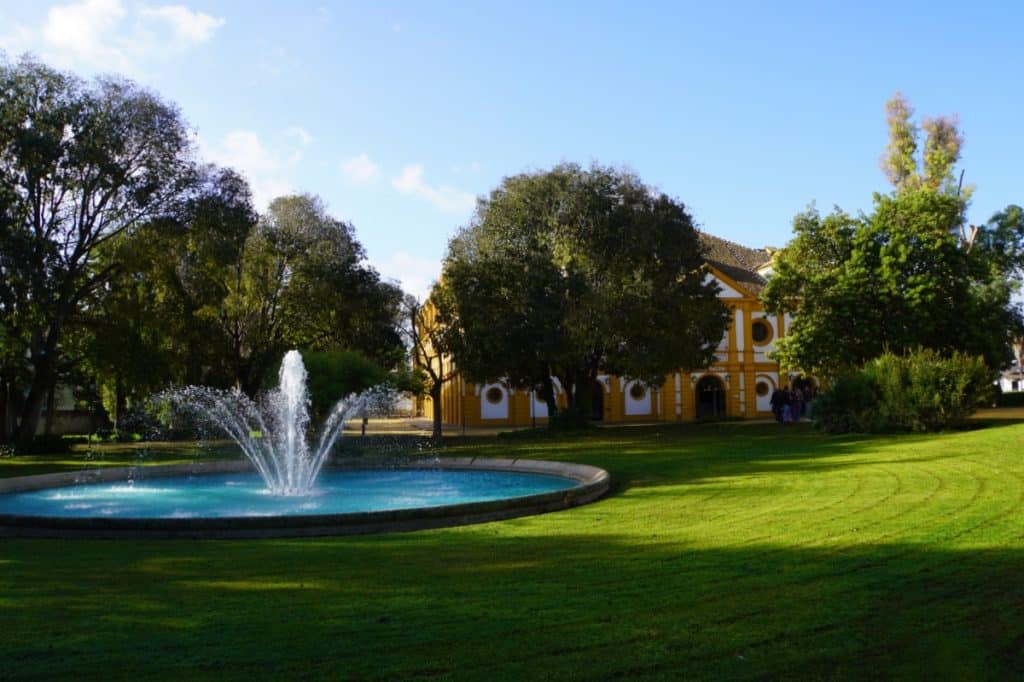
The Recreo de las Cadenas is a beautiful building that was designed in the 19th century by Charles Garnier (who also designed the opera in Paris). To the left of the castle is the riding hall with the adjoining stables, behind which are two spacious riding arenas and the saddlery. The complex also includes a carriage museum in an adjacent area.
What different visiting options are there?
Anyone visiting the Royal Andalusian Riding School should book their ticket in advance. Places are limited. There are different offers and not the same thing takes place every day.
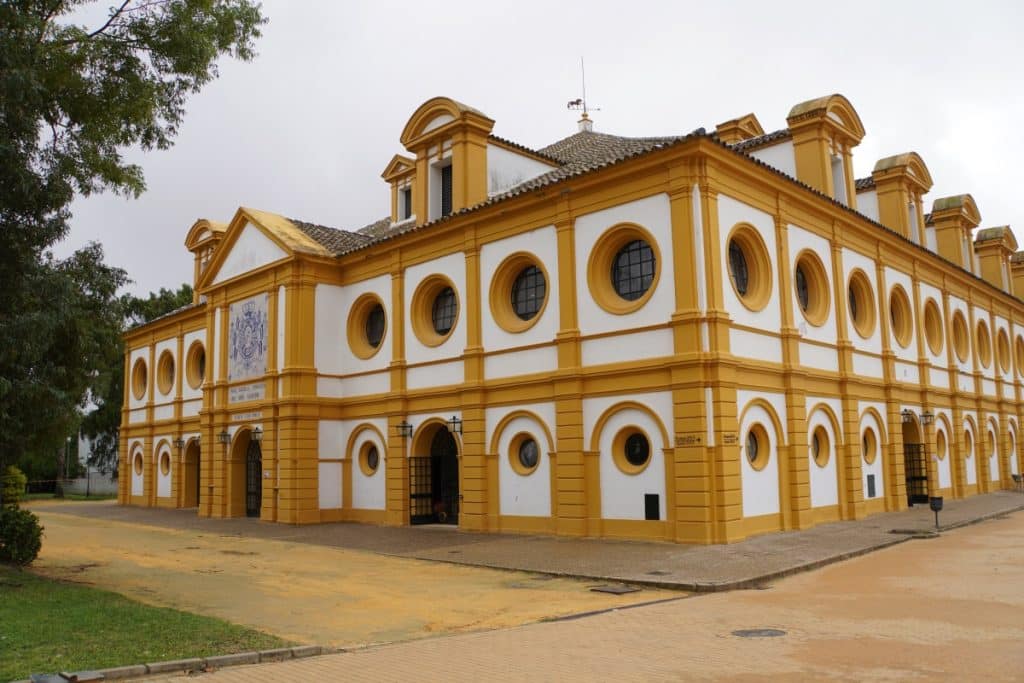
Offer type Training:
Here you can book a visit to the training course, a guided tour of the stables and tack room, an individual visit to the saddlery, the castle, the Museum of Equestrian Art and the Carriage Museum.
Our tip: Make sure you arrive punctually at 10 a.m. when the opening hours begin. Depending on the language you choose (English, French, German, Spanish), the organization on site is slightly different. This was explained to us directly at the entrance.
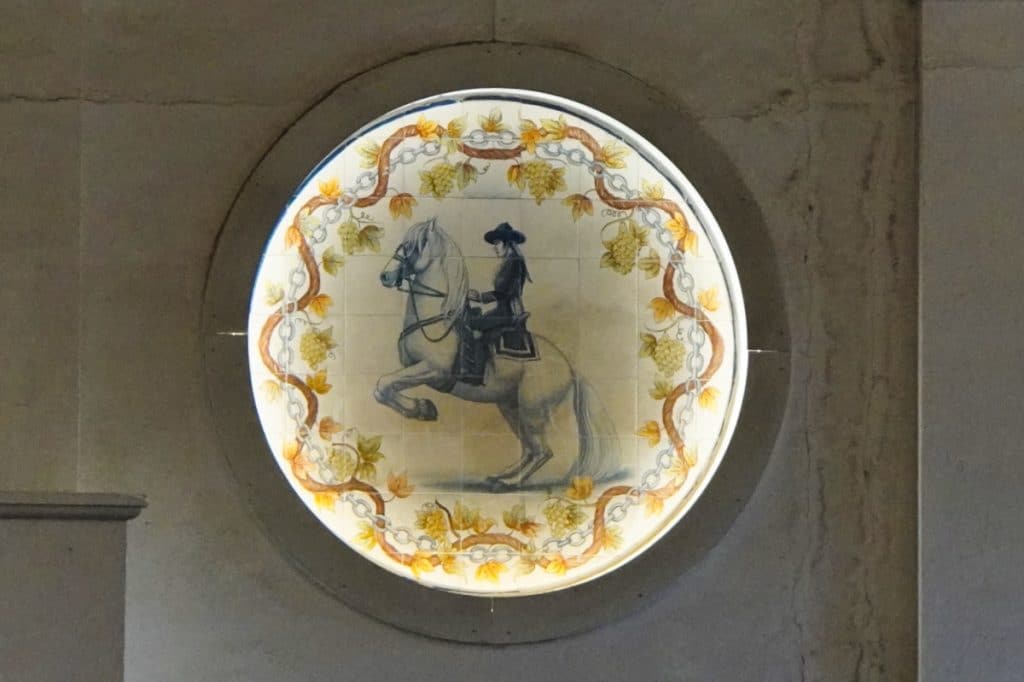
During our visit, the guided tour of the stables took place in German at around 11:15 am. Beforehand, we were able to watch the training (which took place in the hall due to light drizzle, otherwise in the riding arenas) and after the tour there was enough time to explore the museums. However, you have to bear in mind that they only have limited opening hours.
Offer type Show:
Anyone wishing to visit the show will not have the opportunity to look into the stables and tack room. Preparations are underway here and so there are no guided tours. However, it is possible to visit the museums and the saddlery, take a tour of the castle and view the outdoor riding arenas.
History of the Royal Andalusian Riding School
D. Álvaro Domecq Romero, trained at the Spanish Riding School and founded the Andalusian Riding School in Jerez de Frontera in 1973.
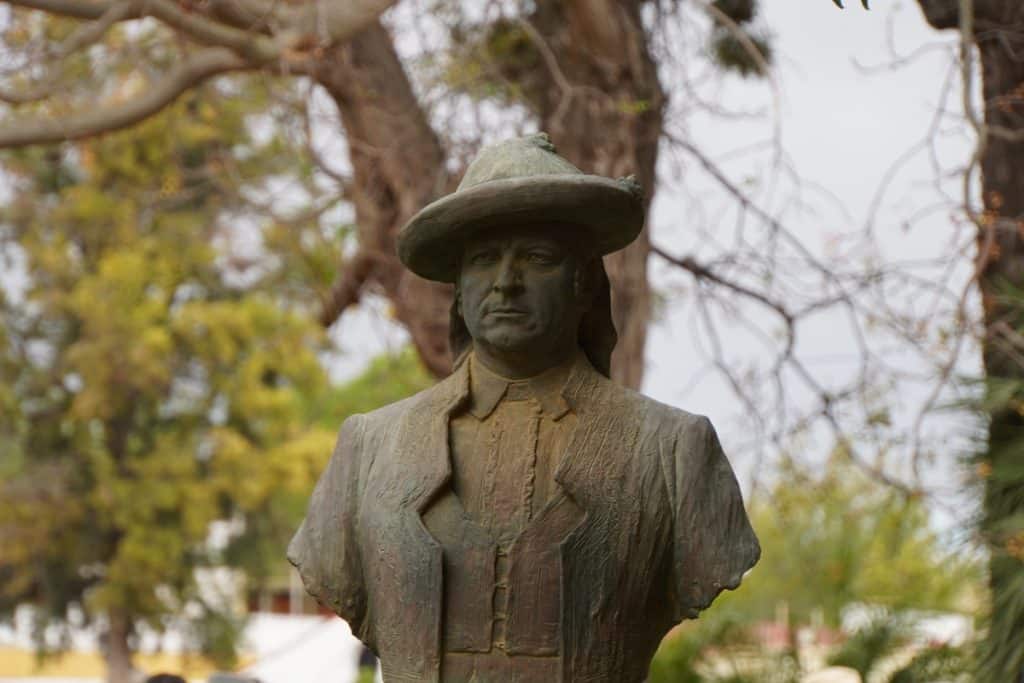
After the Ministry of Information and Tourism took over the management, the Recreo de Las Cadenas castle was purchased and the large riding arena with 1600 spectator seats and adjacent stables for 60 horses was built. There is even a box for the royal family. The management was entrusted to a board of directors, which took over the school in 1983. D. Alvaro Domecq Romero was appointed technical director.
In 1986, the Board of Directors was able to acquire the stables of Don Pedro Domecq de la Riva, which consisted of 35 horses of Spanish breed and a collection of nineteen carriages and the accompanying harnesses, saddles and embroidered clothes for horses and coachmen. Some of the pieces date back to 1730 and are of inestimable historical value. These exhibits form the basis of the museums.
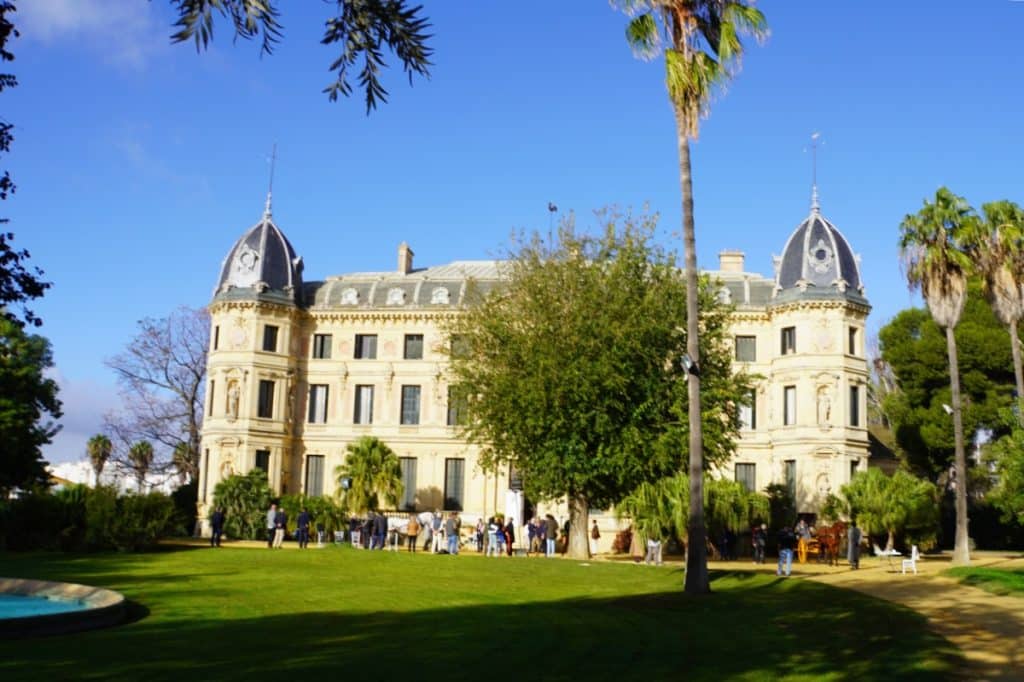
His Majesty King Juan Carlos I – then still Crown Prince of Spain – awarded Don Álvaro Domecq Romero the “Caballo de Oro” (Golden Horse) trophy and the “Royal” recognition in 1987. This is awarded every year in Spain for commitment and work with horses and is one of the country’s most important equestrian trophies. Since then, the riding school has been able to call itself the Royal Andalusian Riding School.
In honor of this award, the founder presented the show “How the Andalusian Horses Dance” for the first time. The royal family also attended.
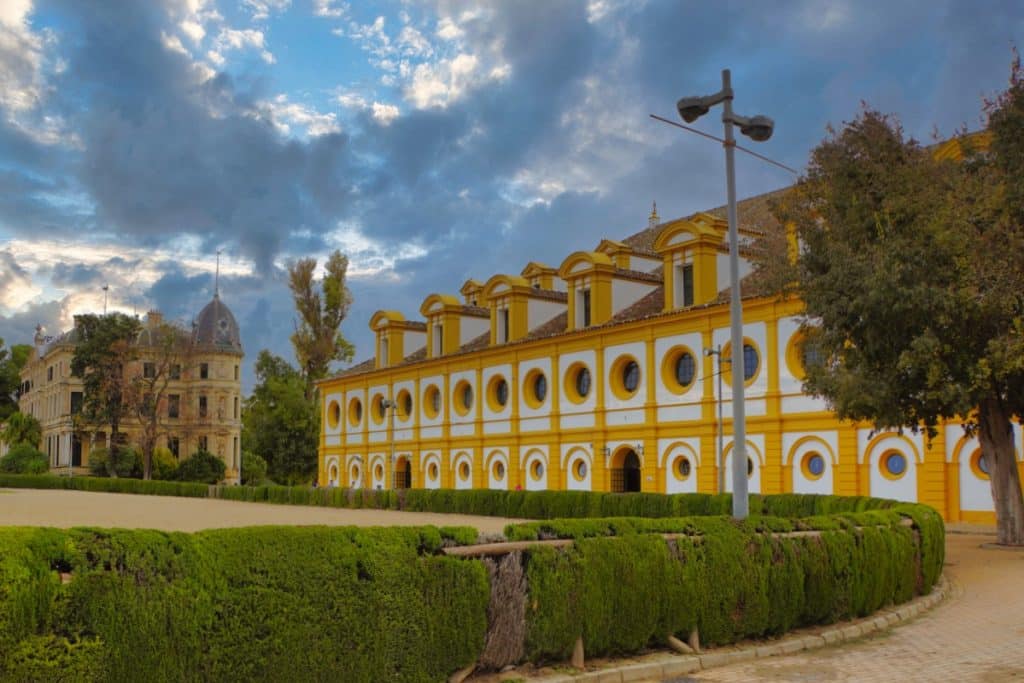
The riding school has been run by a foundation since 2003. In addition to the famous show, the foundation also aims to preserve and promote classical and rural dressage (Doma Vaquera), the training of haute école riders and, of course, the preservation of the Spanish horse breed.
Two of the riding school’s most famous riders, Rafael Soto and Ignacio Rambla, who won the silver medal with the team at the 2004 Olympic Games in Athens on the riding school’s horses, are also particularly proud.
What kind of horses are ridden at the Royal Andalusian Riding School?
Horses have existed on the Iberian Peninsula for a very long time. The predominant breed there was famous all over the world and was often exported to other regions. There, the breed was then crossed with other horse breeds.
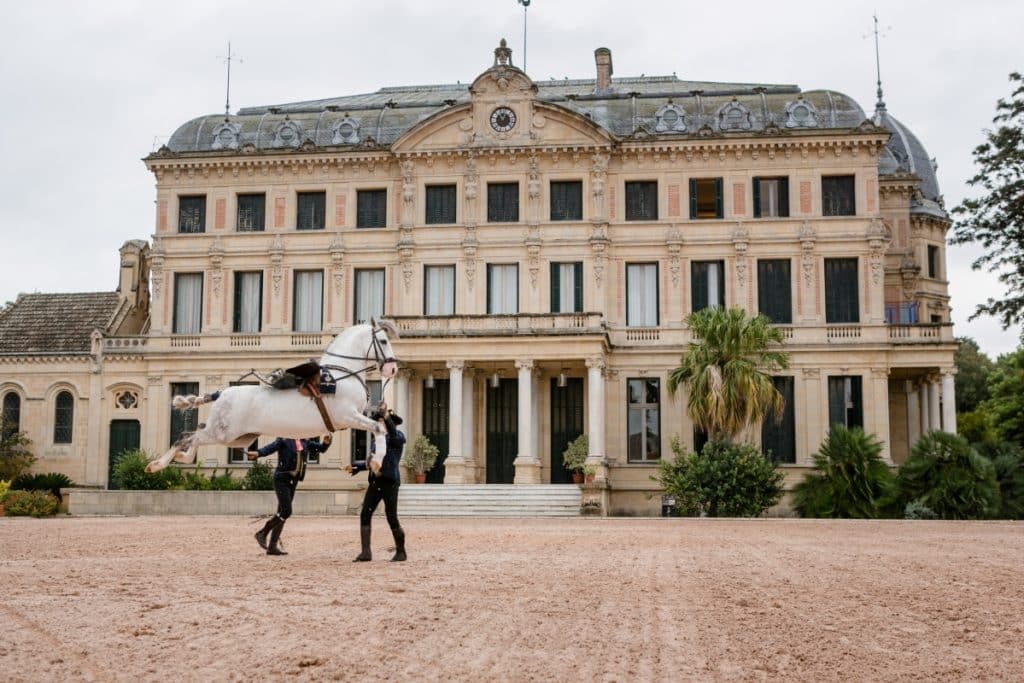
The Spanish horse has some characteristics that are not often found in this combination. They are very agile and have a natural rhythm. The spirited animal is docile and is well suited to dressage. The animal is particularly docile when used in the haute école and in the air above the ground. It is therefore well suited to the arena, parades and demonstrations. Its reliability made the horse breed a favorite of kings and nobles, who enjoyed showing off the animals.
The Royal Andalusian Riding School has around 100-120 horses, although not all of them are stabled in Jerez. The mares and their foals are kept in pastures in the surrounding area and only the stallions and geldings are used in the riding school.
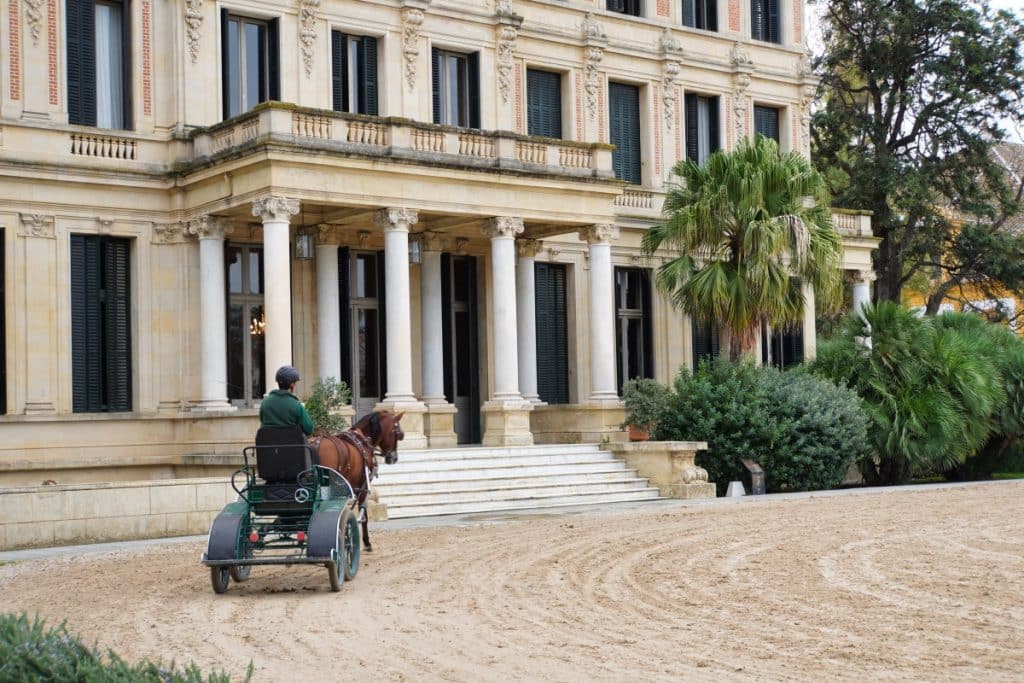
Anyone who wants to become a rider here can apply for an apprenticeship. After two different tests, a small group manages to get one of the coveted places every year. Other riders also have the opportunity to expand their knowledge in the ongoing schooling program. Two-week courses can be taken on the school horses.
A look at the training
During our first visit to the Royal Andalusian Riding School, we were able to watch the horses being trained. Due to a light drizzle, it took place in the riding hall.
Quiet music in the background and concentrated work in the arena, I could really feel the tension of horse and rider. The riding instructors/trainers stood in the hall and spoke quietly into their microphones. You could very quickly tell which student was being taught by which instructor.
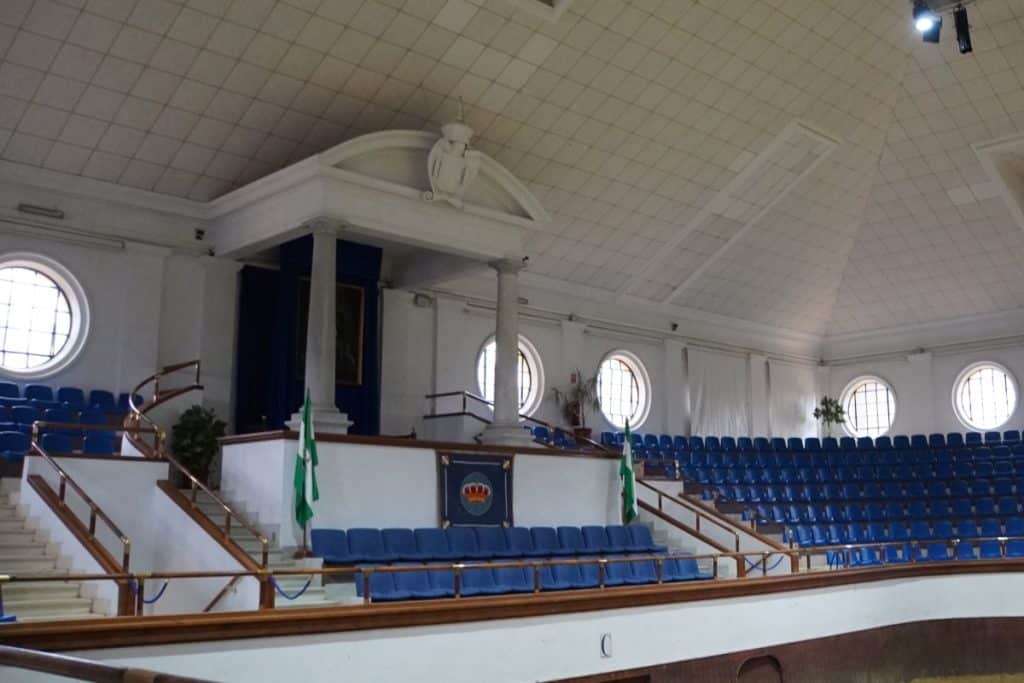
The riders practiced dressage elements in the saddle, but also on the long reins behind the horse. Beautiful passages with long, sweeping trot strides alternated with backhand and forehand turns, traverses and concentrated trotting on the spot.
I found it particularly exciting that the riders also practiced extremely demanding exercises such as levanden (standing on the hind legs) and capriole (jumping with all four legs at the same time).
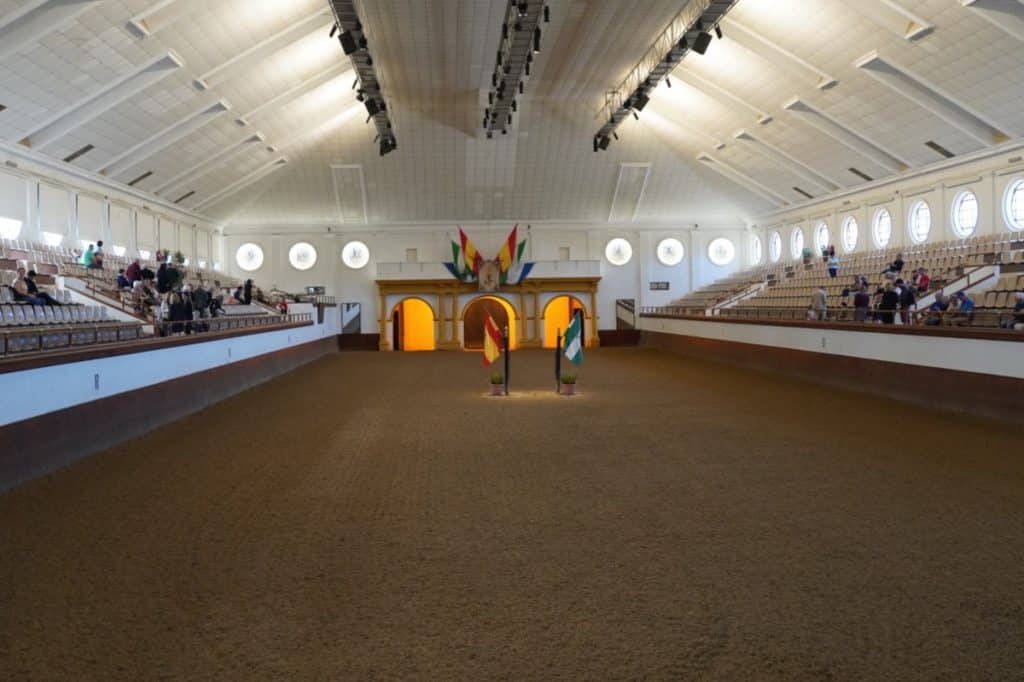
I found it very interesting to watch the very different horses and their riders. At times there were 8 horses in the arena at the same time and I didn’t know who to watch first.
Visit to the stables
You can take a look inside the stables and tack room during the training session as part of the guided tour. For me, as the mother of a daughter who loves riding and has spent countless hours with her in the stables, this is a very special experience. Not only have I never seen such a clean stable and such a tidy tack room, I also found the size of the boxes for the horses to be quite generous.
In the stables, an octagonal complex consisting of five stables with twelve boxes each, we can visit numerous horses. Of course, the names of the horses are written on the boxes and we were able to spot one of the horses that took part in the Olympic Games.
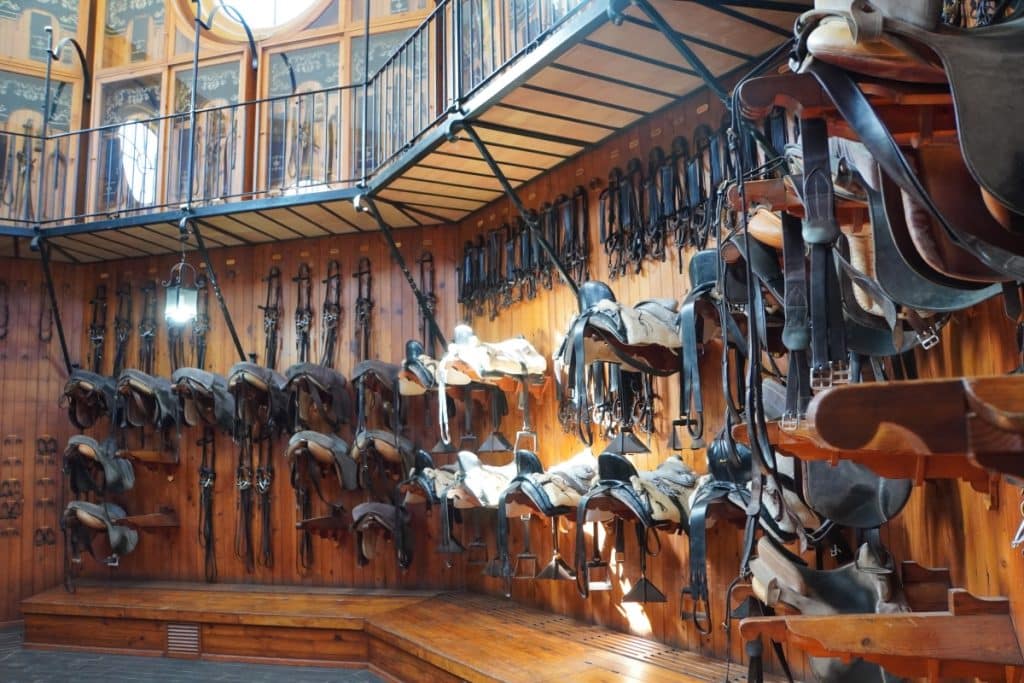
A look into the tack room showed me the variety of equipment needed here. There are different types of saddles for different types of dressage and special saddles for shows. Of course, each horse has its own bridle and funny bobbles to keep flies away from its eyes. As there is room for 60 animals in the various stables, a corresponding number of saddles are naturally required.
A look into the Recreo de las Cadenas
The Recreo de las Cadenas palace is a wonderful example of 19th century architecture. It was designed by Charles Garnier, who also designed the Paris Opera.
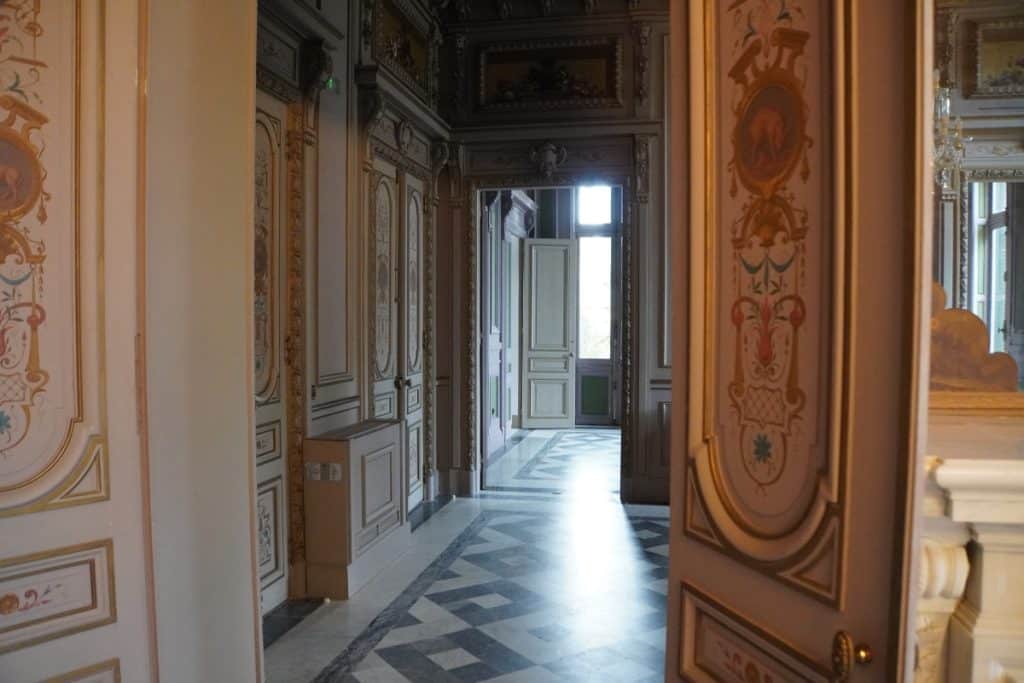
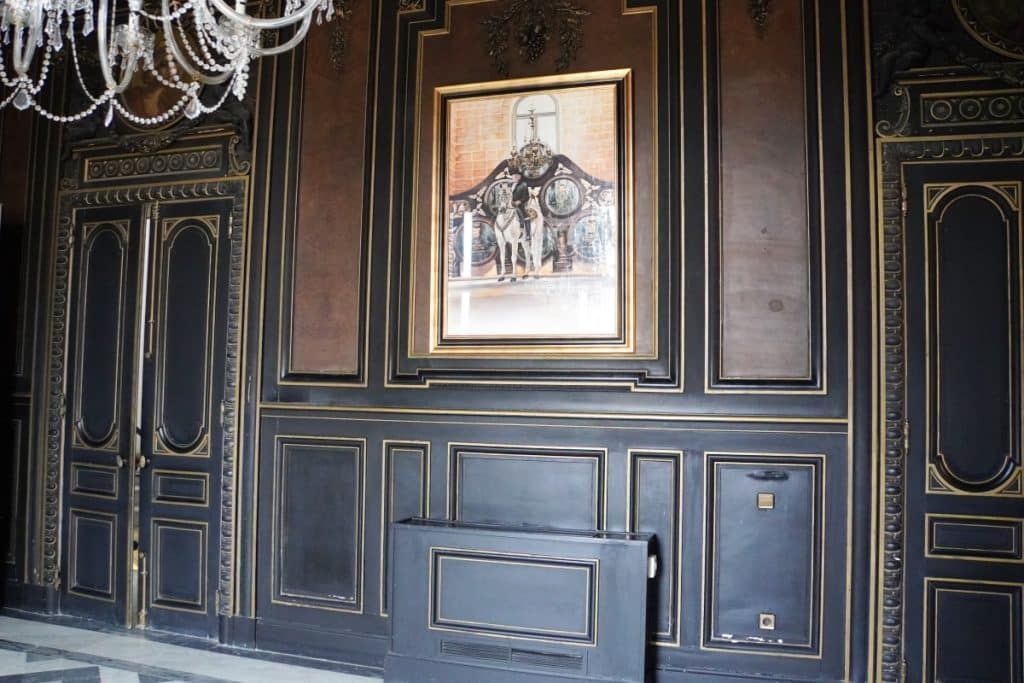
On the first floor there are large and representative rooms that you can visit. Each room is designed differently and I really liked them.
There are training rooms and a library on the two upper floors.
Museum of Equestrian Art
Since 2005, the Royal Andalusian Riding School has been home to the Museum of Equestrian Art. It is located in the basement of the Recreo de las Cadenas and guides visitors through the origins and development of horsemanship from its beginnings to the present day. The aim is to preserve the Andalusian equestrian heritage.
On the tour through the 11 thematically different rooms, I discovered a lot of interesting information about riding, horses and the riding school. The most important topics are, for example: the origins of equestrianism in Andalusia, the history of the Royal School, the origins and development of the horse and the world equestrian championships.
Visit to the saddlery
The saddlery is located in a slightly smaller building. This is where the master saddler and his apprentices work on the riding school’s bridles and saddles.
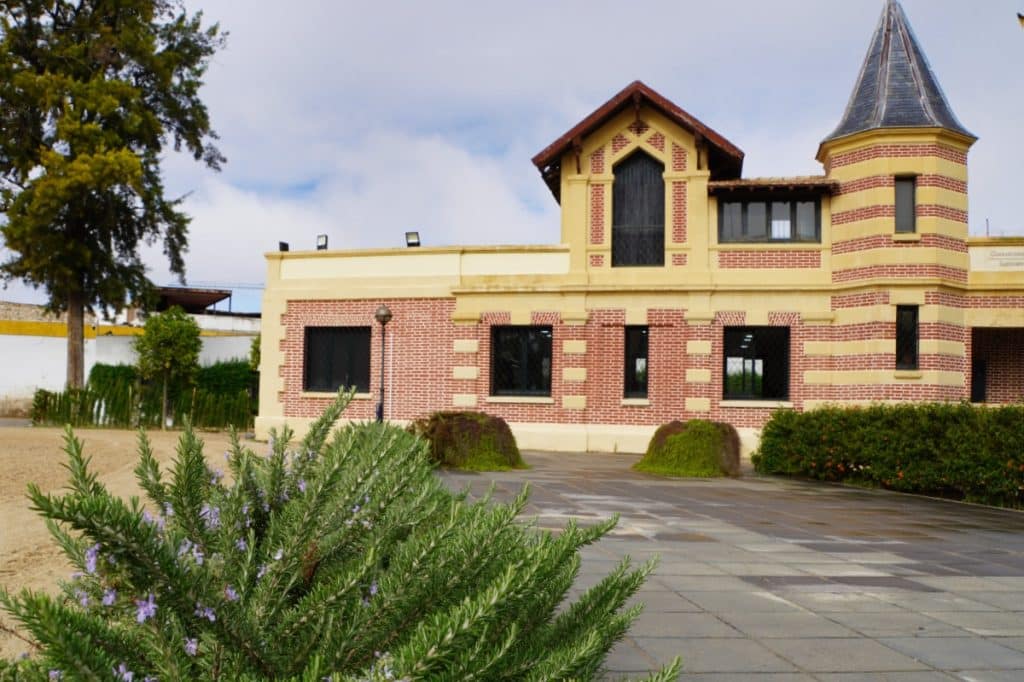
Of course, daily use causes wear and tear, which is repaired by hand. In addition, the very special saddles required for shows and work with Spanish horses are also made here.
Carriage museum in Jerez del Frontera
The carriage museum of the Royal Andalusian Riding School is located on the site of a former 19th century bodega. Several exhibition rooms, stables for carriage horses and the necessary service facilities such as workshops were opened in 2002.
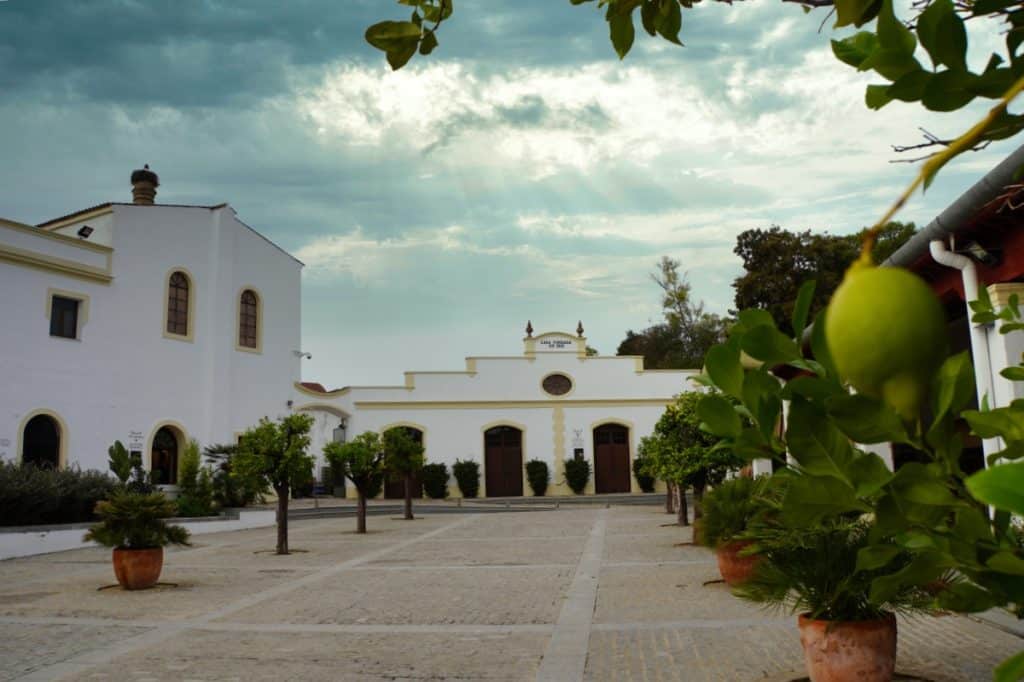
During a tour, we come to a very elegant exhibition hall. Here we see gleaming, polished carriages from various centuries, the matching bridles, harnesses and accessories for use. With the help of multimedia displays, you get a great impression of how the beautiful carriages are used.
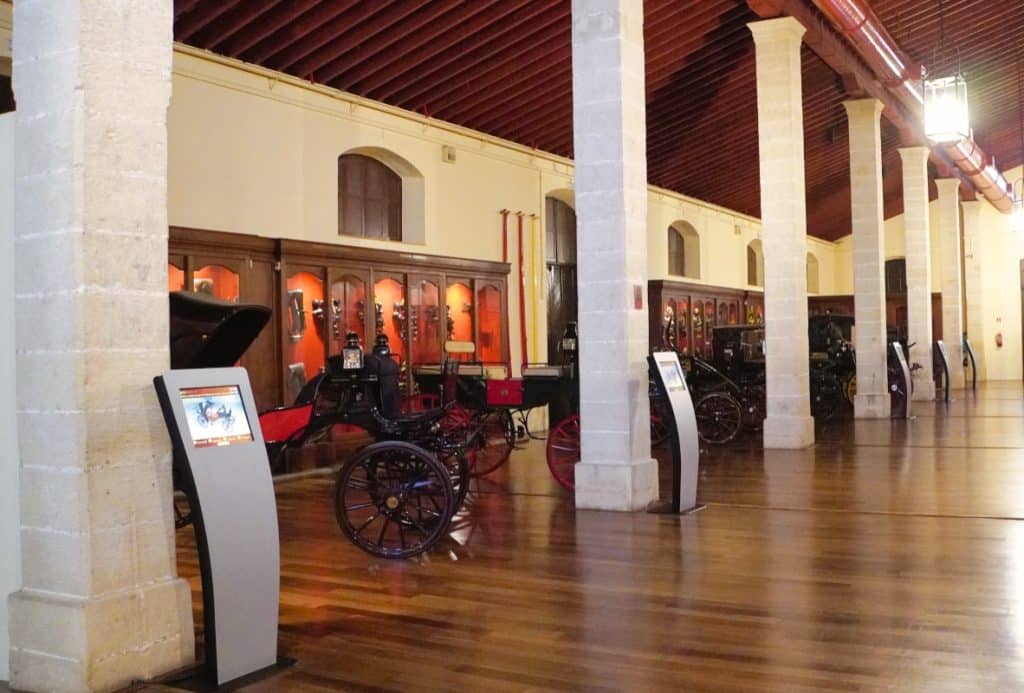
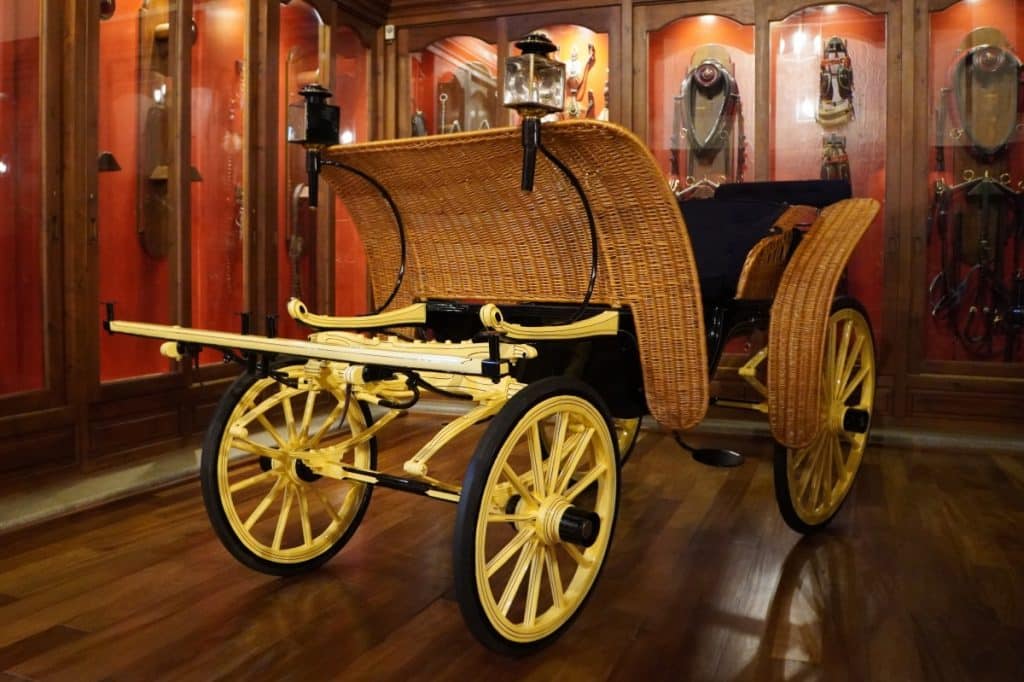
We also discover a very special carriage. Elena of Spain was driven to her wedding in this carriage by 4 horses from the Royal Andalusian Riding School.
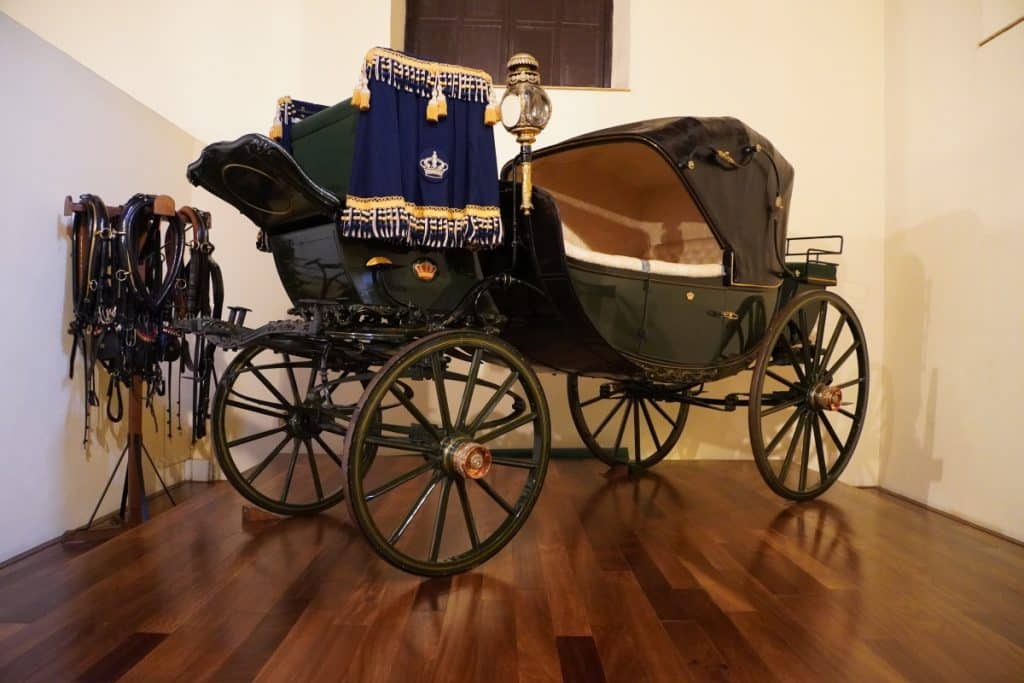
A walk leads to the stables of the horses used by the Royal Andalusian Riding School for carriage driving. Beautiful Spanish thoroughbred horses stand in the stalls and just before they are needed for training or the show, the coachmen take them out to be cleaned. The carriages are then ready and polished and after harnessing them up, the work with the animals begins. They drive across the road to the grounds of the Royal Andalusian Riding School.
One room of the exhibition shows the clothing worn by the coachmen depending on the task. In training, at shows and in competitions, the outfit is always stylish, elegant and dignified.
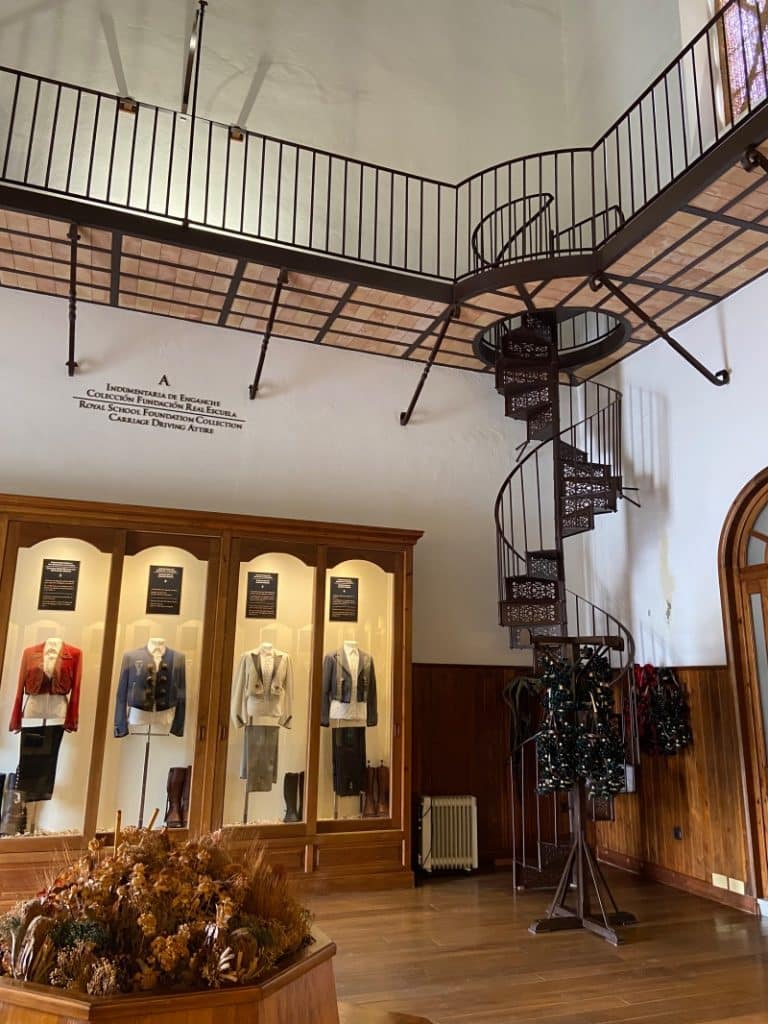
6th International Competition for Traditional Carriages
Special events with international participation also take place on the grounds of the Royal Andalusian Riding School. We were able to observe a competition in which carriages from many different countries took part.
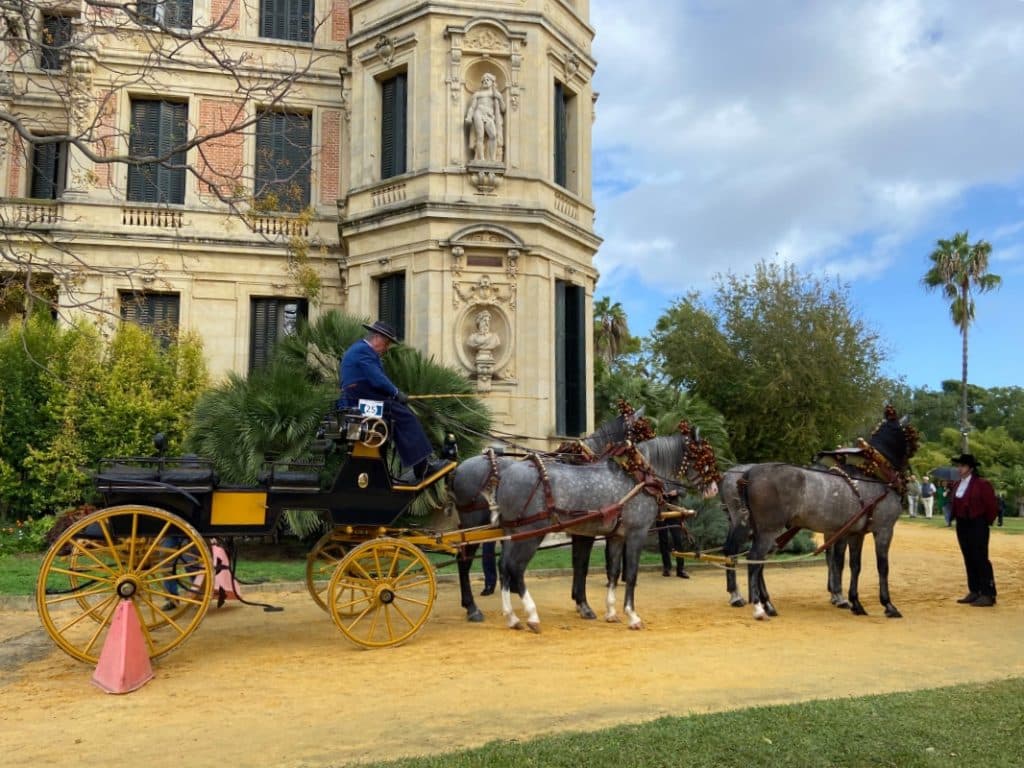
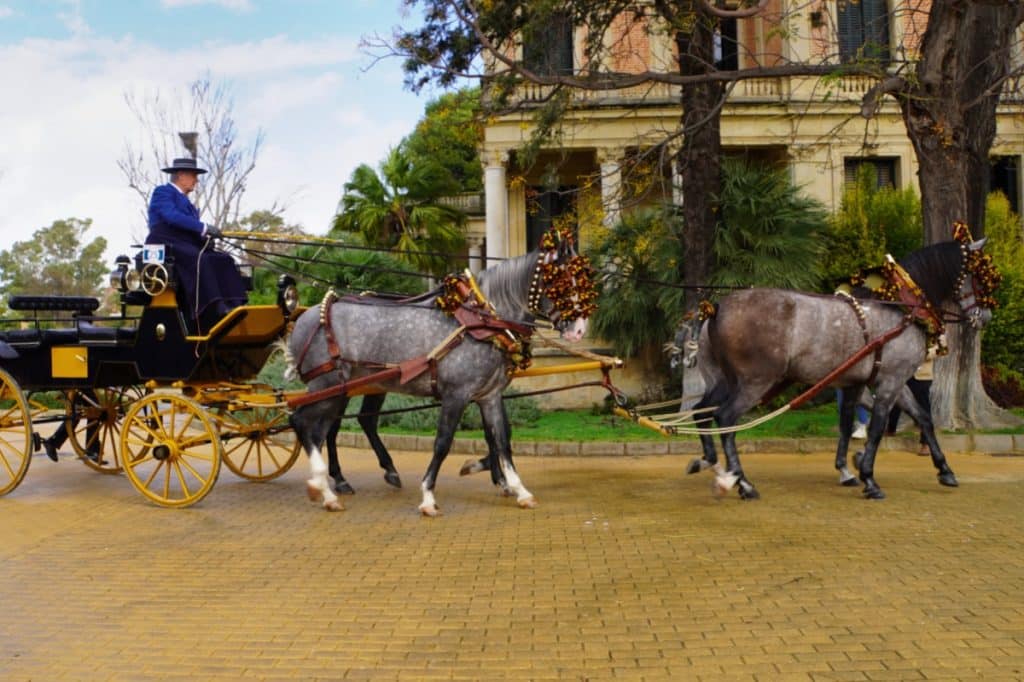
It all began with the presentation of 30 different carriages. Some of the carriages were very old and were driven in the style of the time. Of course, this included the appropriate harness and the clothing of the coachmen and their assistants also had to match. I was amazed at how different not only the vehicles were, but also the harnesses.
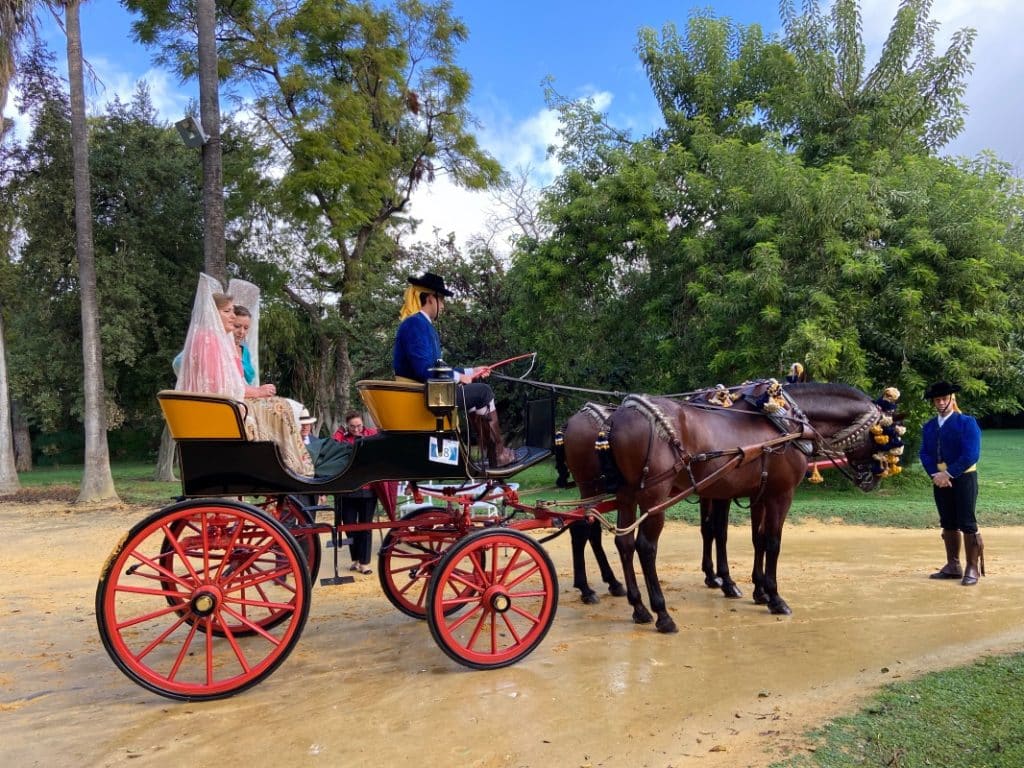
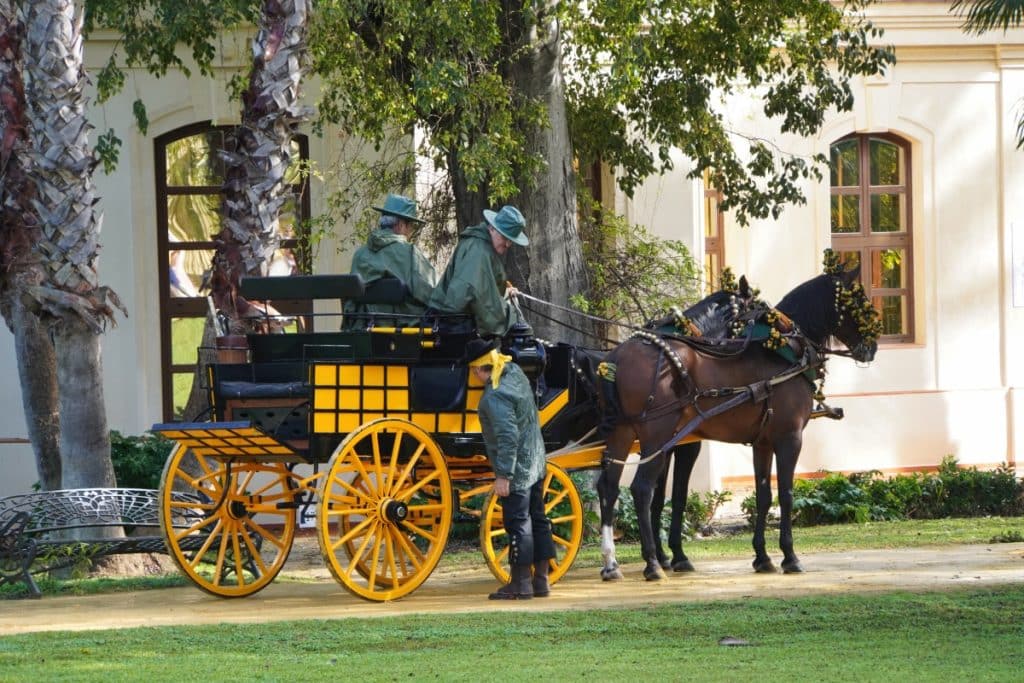
Some of the snaffles looked rather plain, while other carriages had traditional snaffles with lots of pom-poms. Each carriage and its horses drove in front of the jury. The judges assessed the carriages according to various criteria and awarded points. I found it particularly exciting that the track width of each carriage was measured at one point. This was to play a decisive role later on.
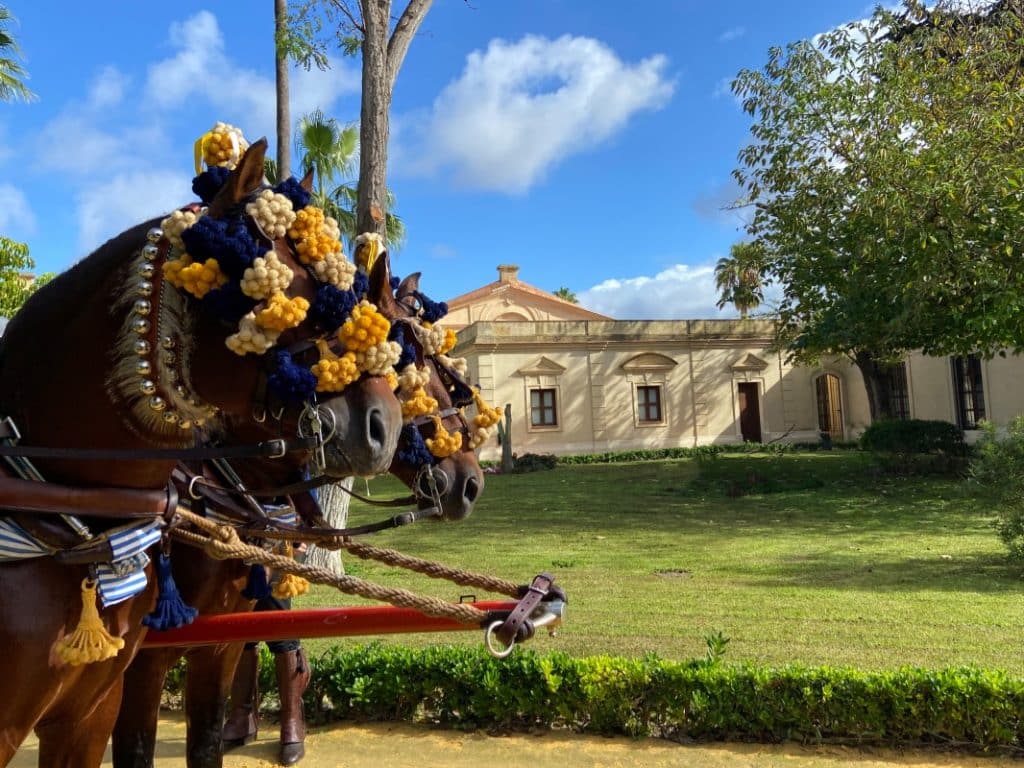
After the inspection, the teams went to a gate that led directly onto the road. The drivers were given a route plan for a 10-kilometer route through the city. The roads were not closed off for this, however, and the tour took place between cars, motorcycles and pedestrians. They also had to stop at traffic lights and still drive as fast as possible, as the time was measured. Some of the coachmen set quite a pace shortly before reaching the Royal Andalusian Riding School again and let the horses gallop along the road.
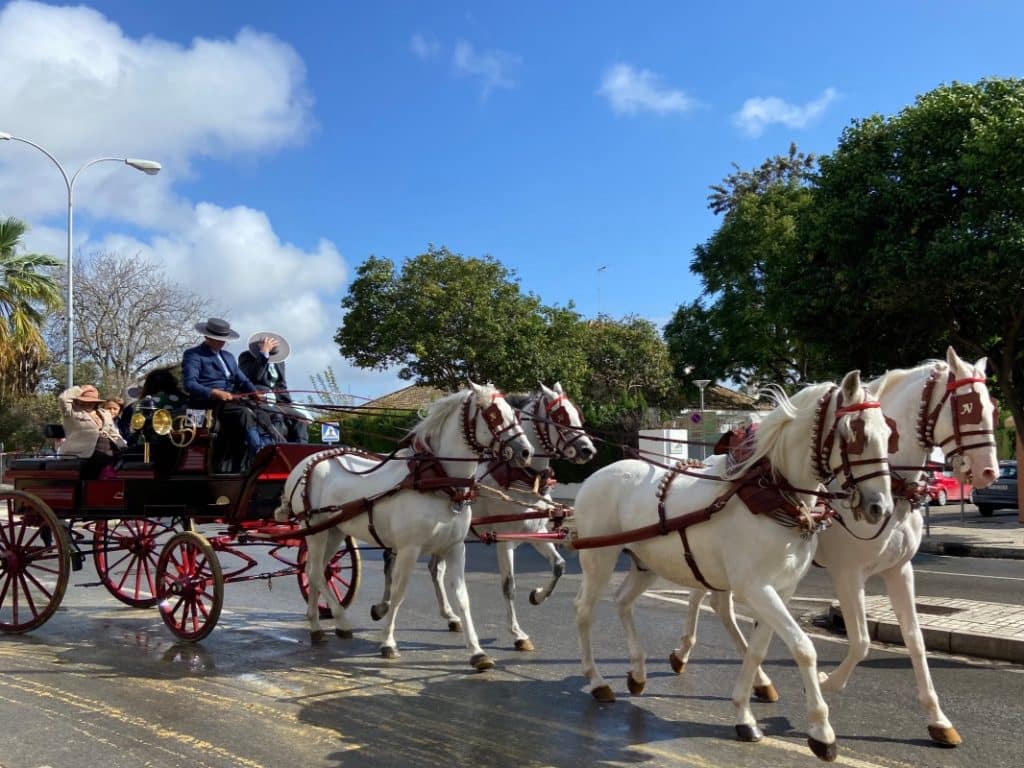
The third part of the competition consisted of a drive through a course. For this, gates had always been constructed from two marker cones, which the coachmen had to drive through in a certain order. Yes, and this is where the track width of the carriages measured at the beginning came into play. Before each ride, helpers went from gate to gate and positioned the cones so that the carriages could drive straight through.
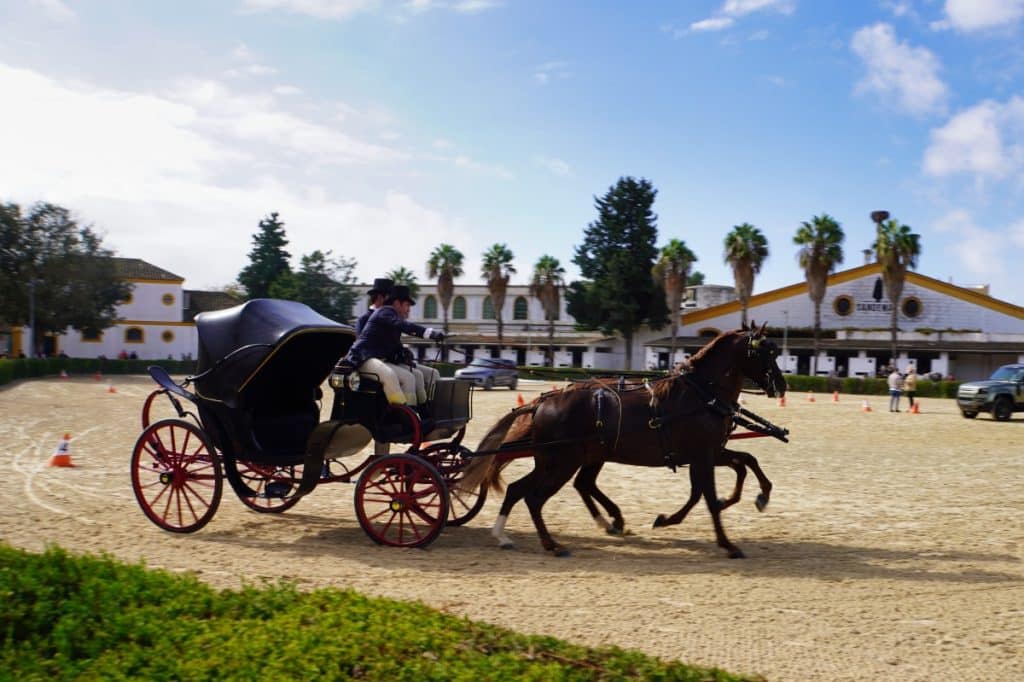
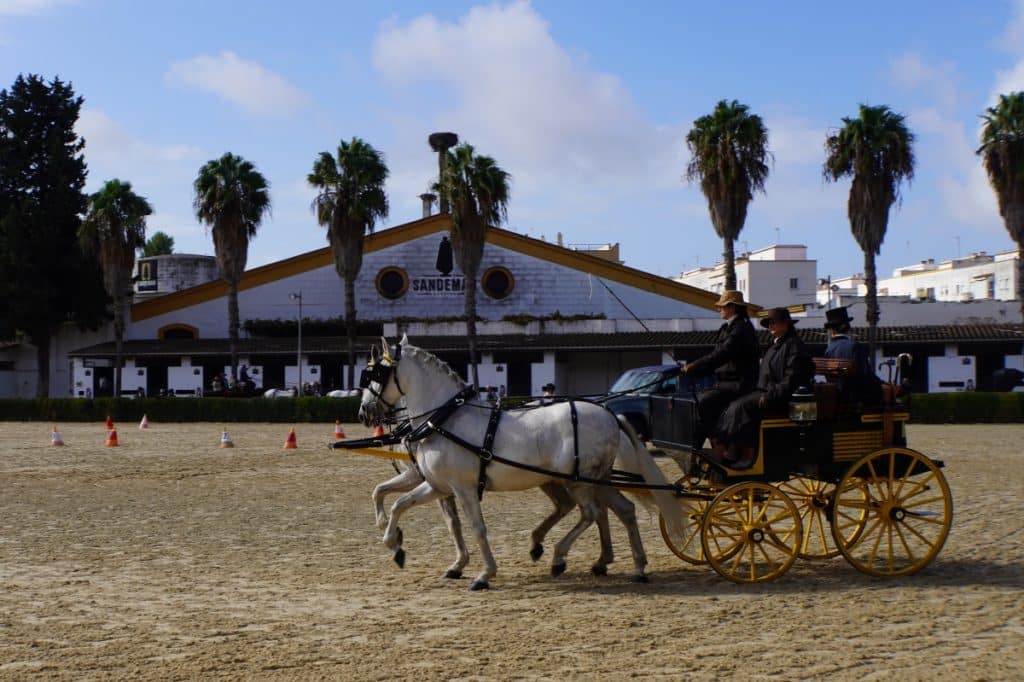
It takes a lot of skill to steer the horses so that they don’t touch the cones. I found it particularly exciting that there were tennis balls on the cones that were not allowed to fall off. The time taken by the team to complete the course was also measured.
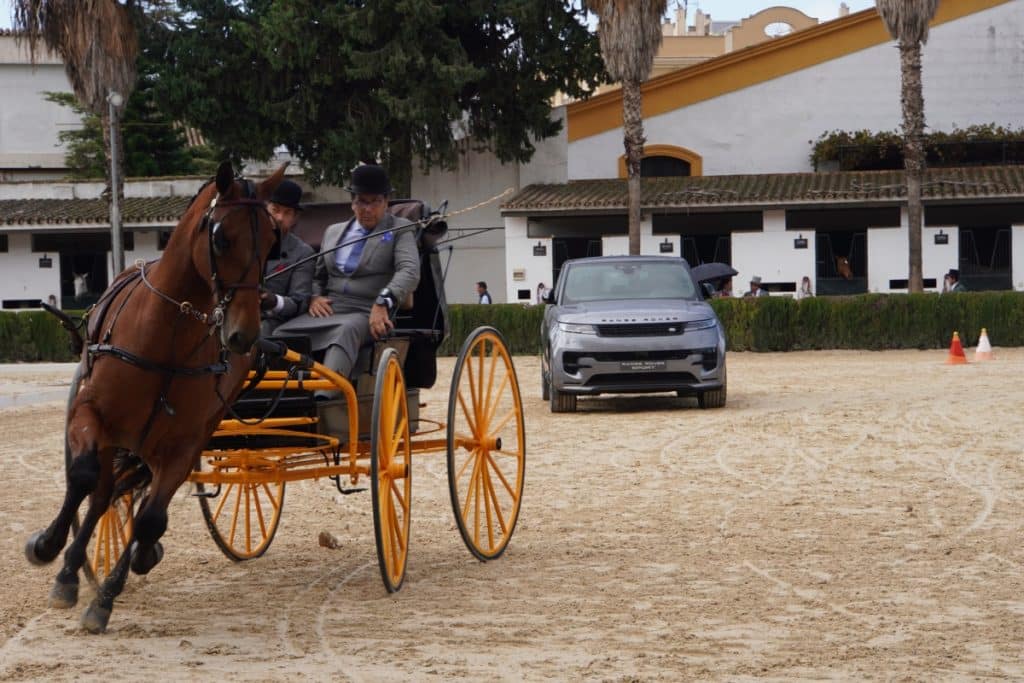
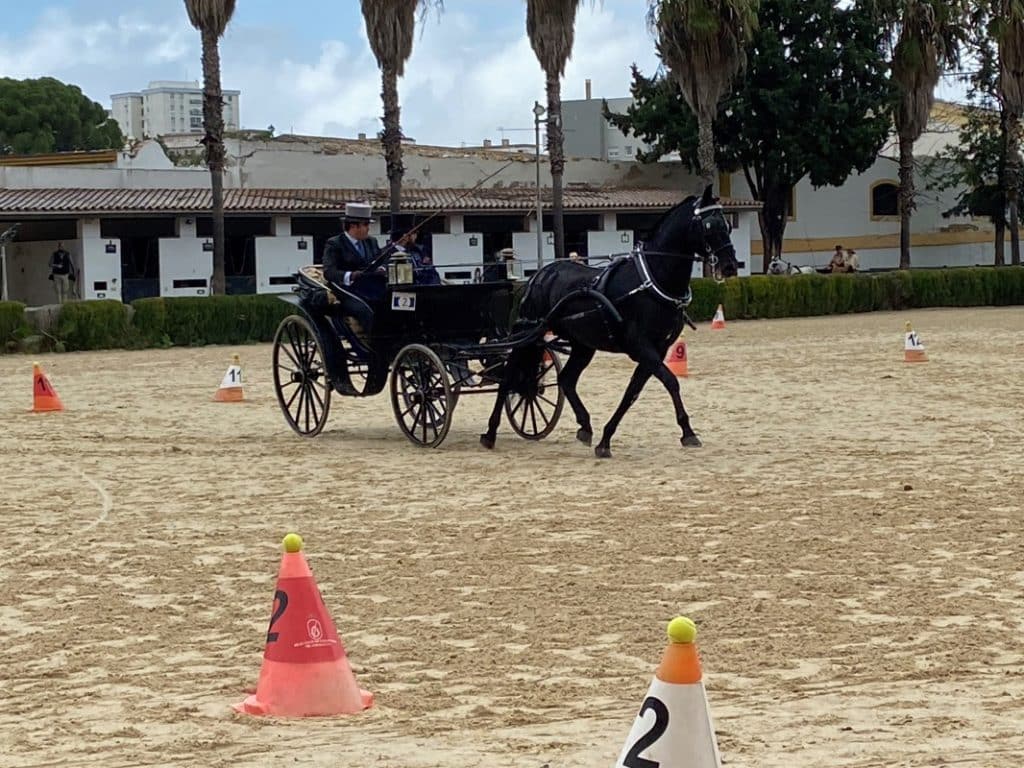
Of course, winners are also determined from all three individual rankings, depending on the “class”. And I think that everyone is actually a winner. I think it’s a great sport to maintain such a wonderful tradition and show it to the spectators.
I am still very enthusiastic about this event. The wonderful carriages with their proud horses were really worth seeing. Especially when they stood in front of the palace, it looked as if they had always belonged there. What a glimpse into the past.
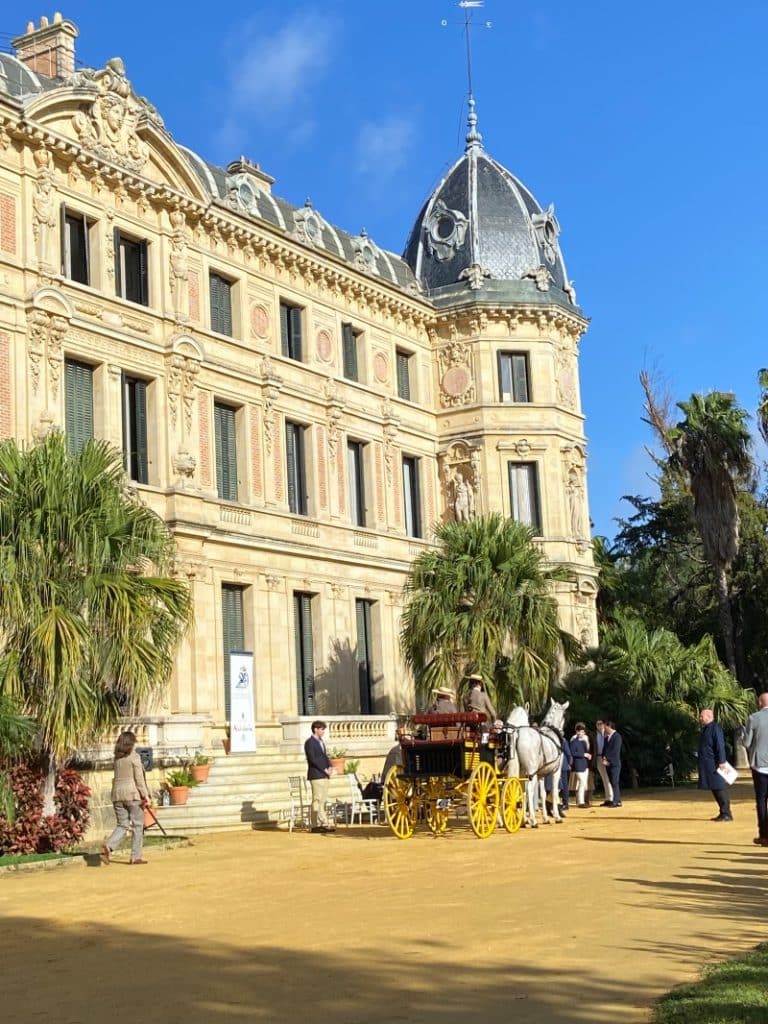
The event takes place once a year.
Show “How the Andalusian horses dance”
The highlight of a visit to the Royal Andalusian Riding School is, of course, the show. This takes place on 3 weekdays from August to October, on 2 weekdays from March to July and on one weekday from December to February at 12 noon. If you want to see the show, you should definitely buy your ticket in good time. The show is often fully booked, especially during the main tourist season.
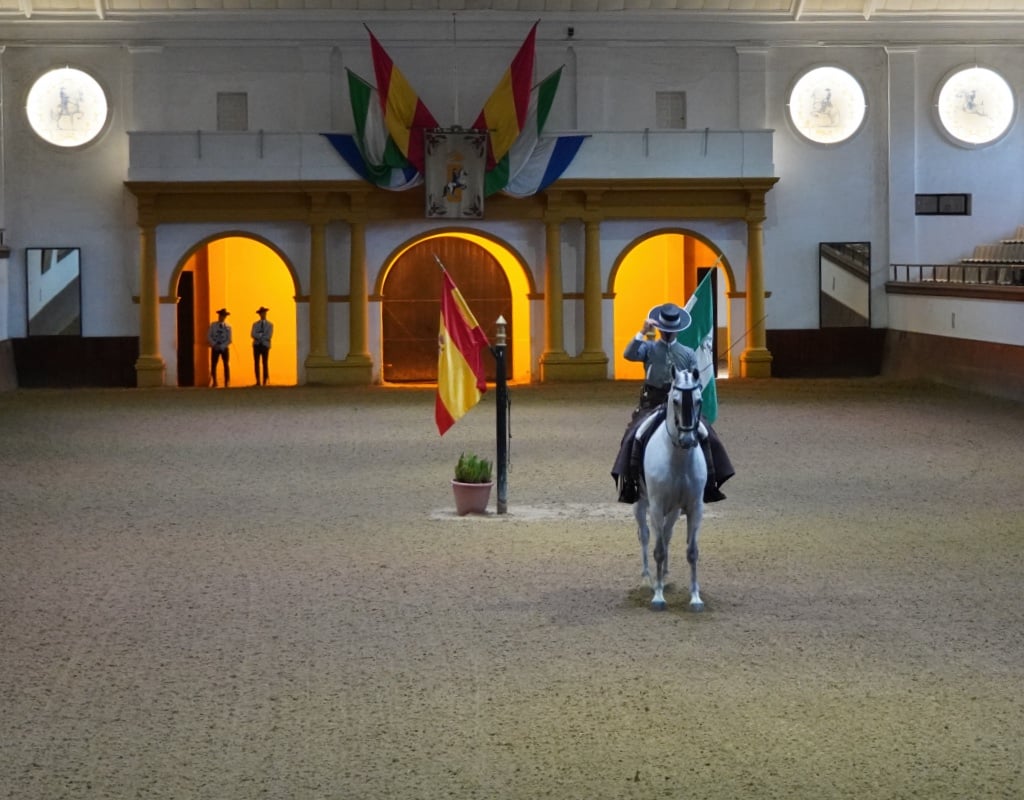
In 90 minutes, riders and coachmen put on an incomparable show with their horses. At times you really get the feeling that “the horses are dancing” to Spanish music.
View of the show
When we watched the show, we could see different choreographies:
Doma Vaquera:
Here the riders demonstrate the skills that are required of a rider and his horse in traditional cattle breeding. For example, pirouettes and arreones (gallop changes) are demonstrated.
Classical dressage:
To wonderful music, several horses came into the arena and performed dressage exercises at various levels of difficulty. From piaffe to voltes and traverses, there was a lot to see. I particularly enjoyed the part of the show in which two riders rode a freestyle together.
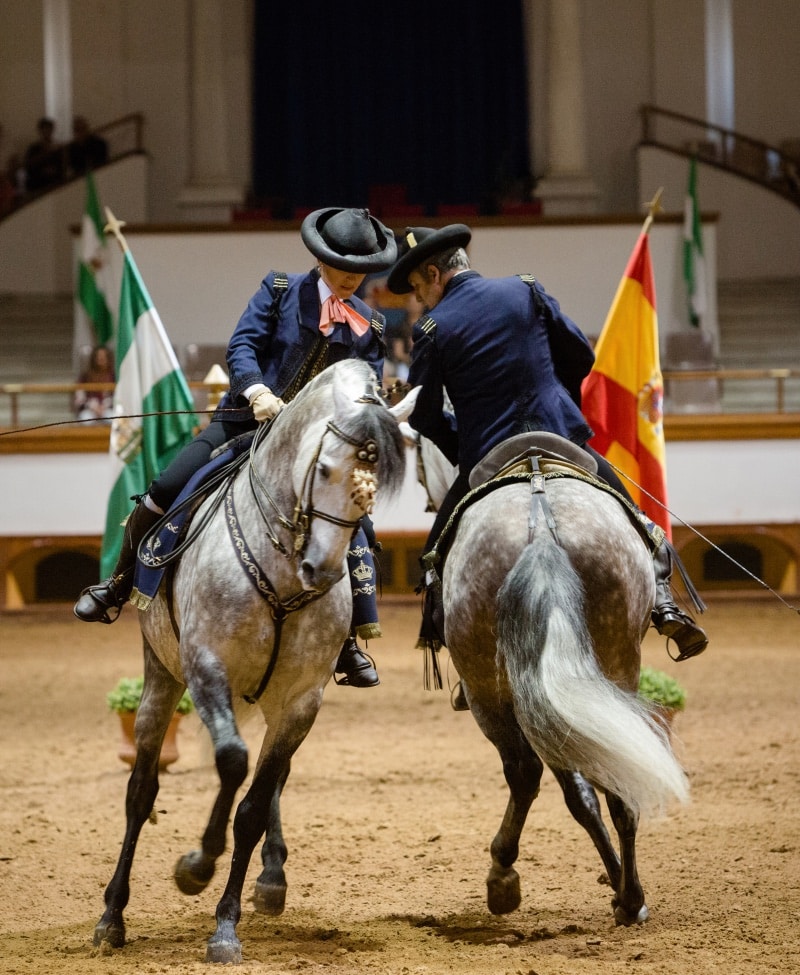
Work in hand:
Here the horse is led through the riding arena on the reins. The horse and rider teams demonstrate classic dressage exercises from the high school, such as the Spanish walk, levades, capers and piaffe.
I found the work on the long reins, where the rider walks behind the horse, particularly interesting.
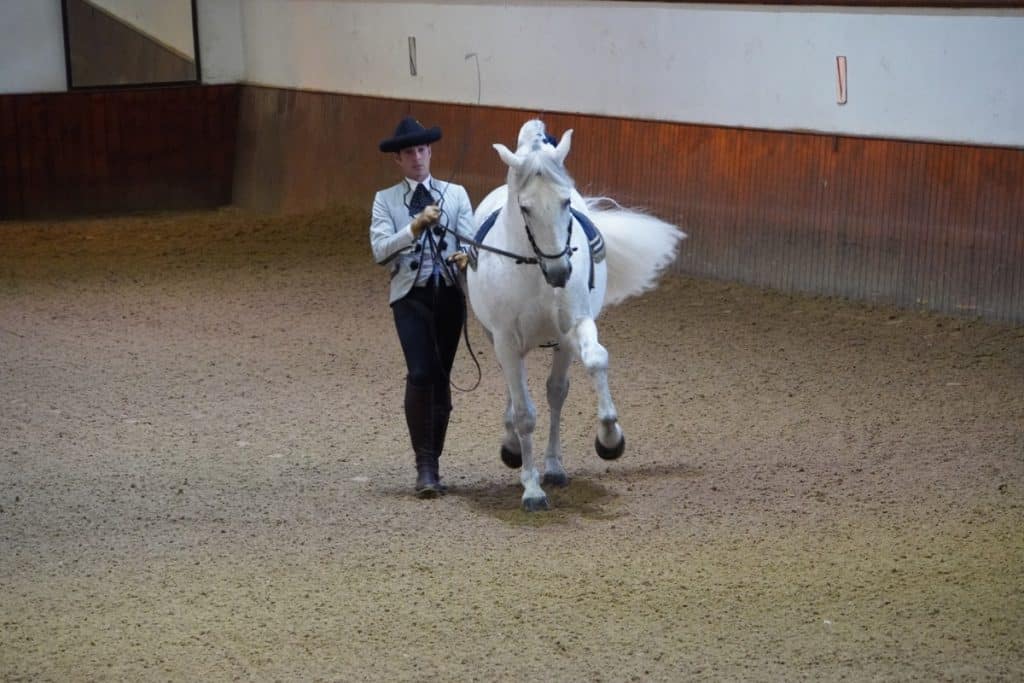
Carriage rides:
One item on the program was the carriages. Single, double and four-in-hand carriages drove simultaneously in the hall. I found it very exciting to see the precision and speed with which the teams drove.
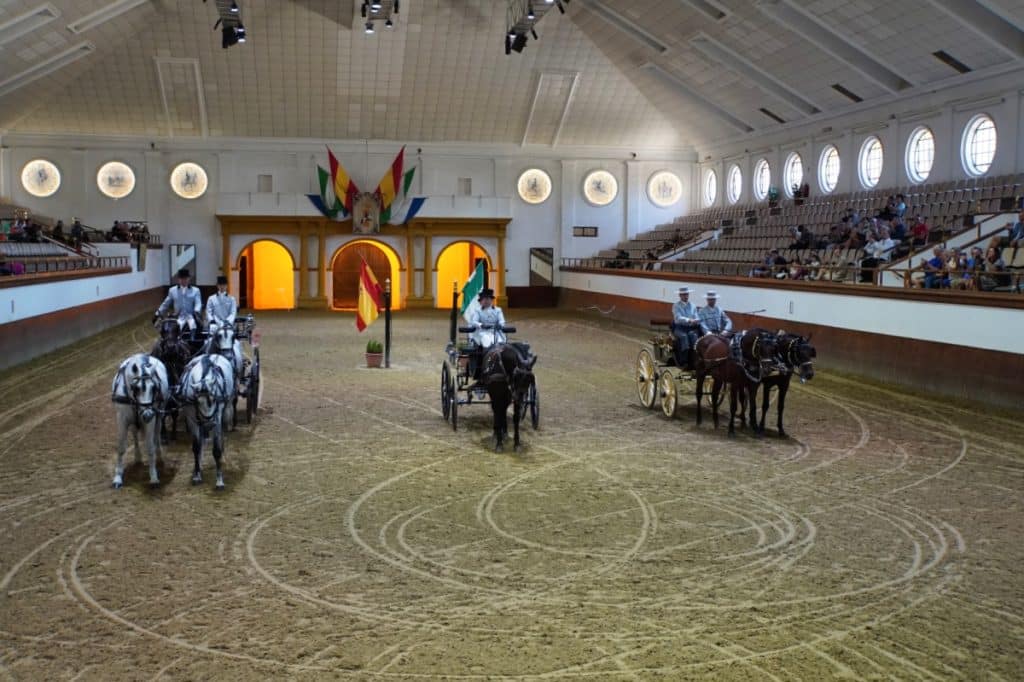
Quadrille:
The final event was a quadrille. Here, 8 riders come into the arena with their horses and perform a perfectly rehearsed choreography to music as a group.
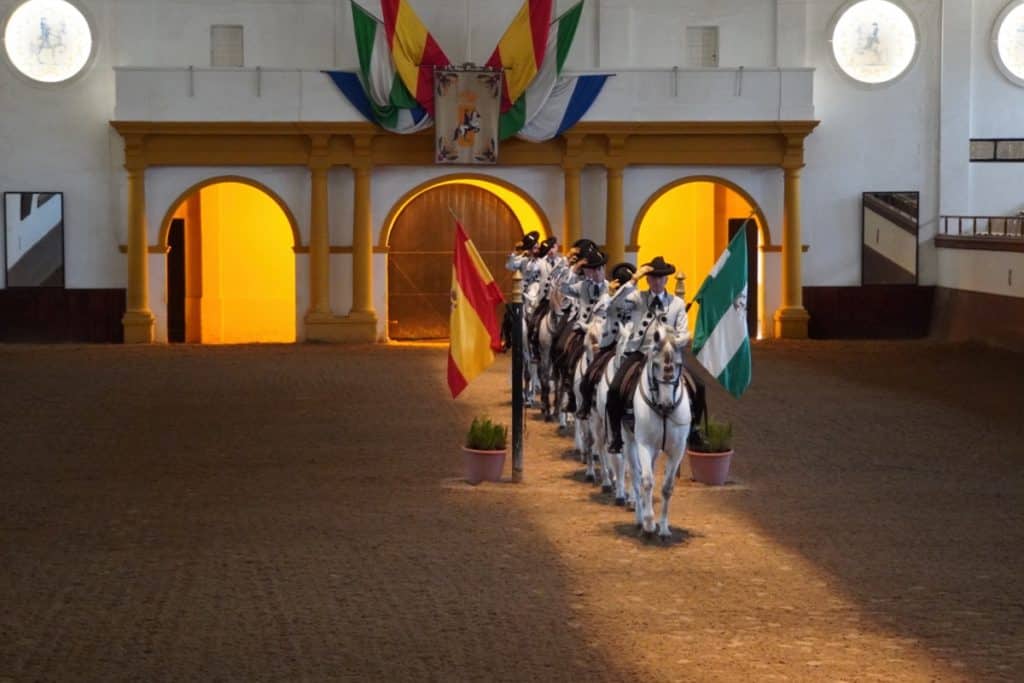
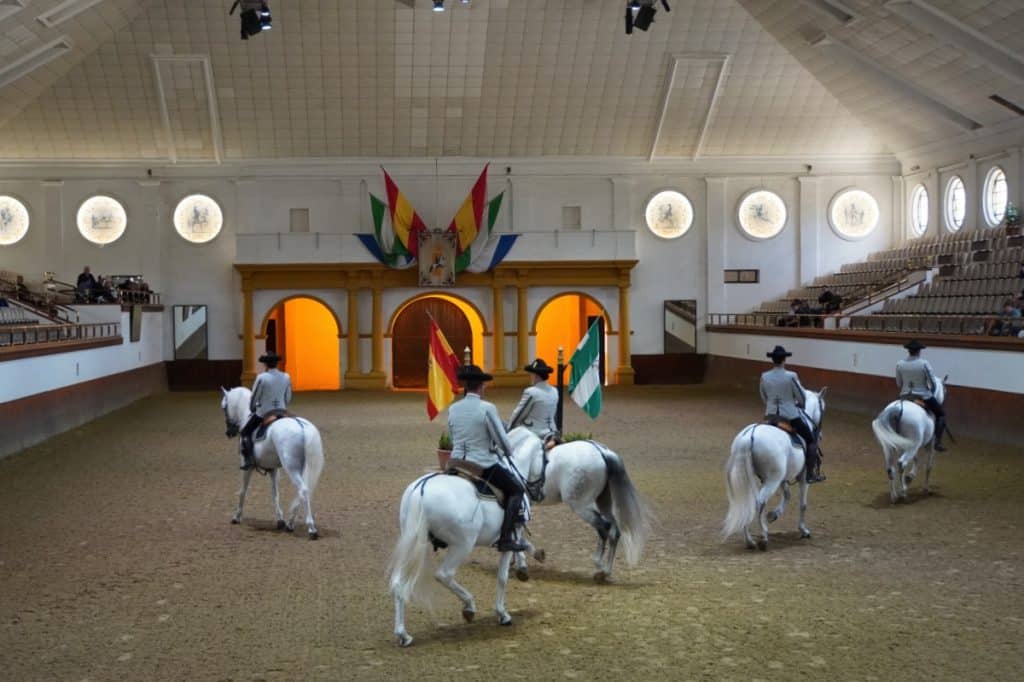
Tickets for the show: “How the Andalusian horses dance”
Adults: from € 24.00
Reduced: from 15,00 €
Aadress:
Av. Duque de Abrantes,
11407 Jerez de la Frontera
Visits:
Full visit
Training sessions in the riding hall, visit to the facilities of the Royal Andalusian Riding School (Recreo de las Cadenas, Museum of Equestrian Art, Carriage Museum, Saddlery, guided tour of the stables)
Opening hours:
January-December:
Monday, Tuesday, Wednesday, Friday: 10-14 h
Admission prices:
Adults: 12,-€
Discounts are offered.
Short tour
Visit to the facilities of the Royal Andalusian Riding School (Recreo de las Cadenas, Museum of Equestrian Art, Carriage Museum)
Opening hours:
January-December:
Thursday: 10-14 o’clock
Admission prices:
Adults. 7,-€
Discounts are offered.
The visit to the Royal Andalusian Riding School took place as part of a cooperation with the Department of Tourism of Jerez. The photos are used with the permission of the Royal Andalusian Riding School of Jerez.
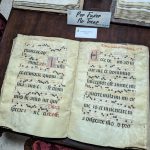
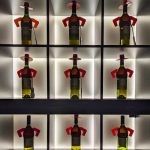
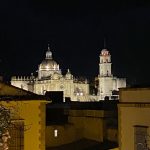
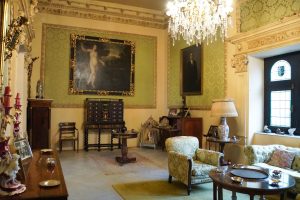
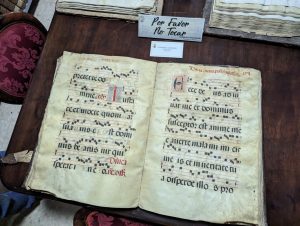
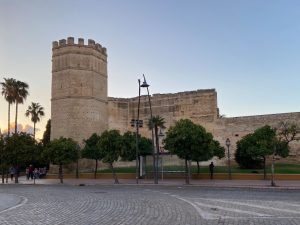
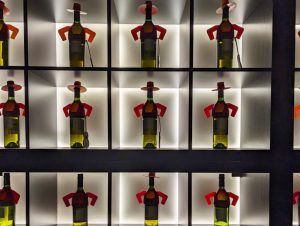
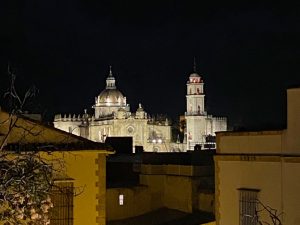
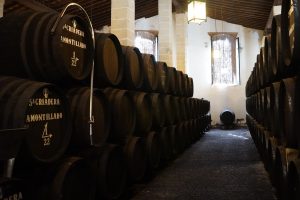
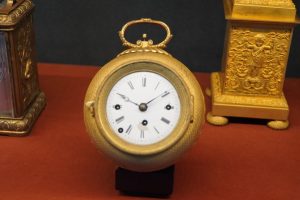
Leave a Reply